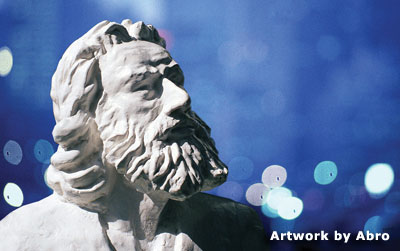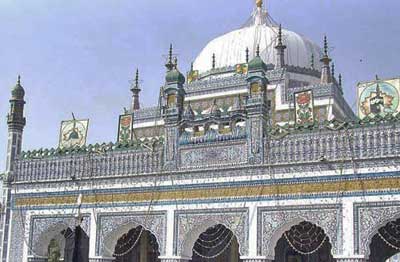
|
Bhittai: the Visionary DAWN, Sunday, January 31, 2010  By Khurram Ali Shafique
Some people say that he fell in love, left home, became a phenomenon and came back to marry the woman who had been refused to him earlier. There is no way of knowing whether the career of Shah Abdul Latif Bhittai of Sindh actually paralleled the Count of Monte Cristo so closely (and we need to be careful about apocryphal stories woven around the lives of great saints), but there are other testimonials to the warmth of the heart that throbbed in him. The most astonishing is the way his work captured the spirit of a new age that was coming up not only in the Muslim world but also outside. Bhittai was born in 1689 and died in 1752. This was when the Muslim world seemed to be awakening to the realisation that a universal ideal could be manifest in regional forms. Hence Abdul Wahhab in Hejaz set out to distinguish between the crux of Islam and historical accretion while Shah Waliullah of Delhi taught that the traditional model of Islam was an application of its ideals in the context of the seventh century Arabia and many other applications were possible in other contexts. Surprisingly, the new ideals that started developing in Europe around this time also converged on regional states. The only poet from that period whose work may be said to represent all possible facets of this new life on behalf of everyone was Bhittai. If the works of earlier Sufi poets from any region were translated into another language they would all sound the same, but the work of Bhittai could not lose its local reference in any translation. Yet, it could not be said to be lacking in what was embodied in all others. This was something which, interestingly, would become increasingly pronounced in subsequent popular writers of Muslim India such as Waris Shah, Mir Taqi Mir, Sachal Sarmast, Mir Amman, Mirza Ghalib, Bahadur Shah Zafar, Sir Syed Ahmad Khan, Iqbal and so on. In this string, the poetry of Bhittai serves as the first practical demonstration of the fact that a universal vision could manifest in regional form — or “think global and act local,” as the environmentalists were going to declare much later. How world class poets receive their inspiration is still a mystery, but most Sufi poets who cared for the feedback of their audiences (unlike the proponents of “high literature” in our times) used certain common symbols, metaphors, patterns and designs within designs — mise en abyme — in their work. One such pattern was the Five Divine Presences. Another was the “seven stages” which may have been originally derived from the seven verses of the first chapter of Quran but subsequently it became the framework for strings of seven stories in The Seven Beauties by Nezami Ganjavi and The Seven Thrones by Abdul Rahman Jami, and the seven valleys in The Conference of the Birds by Sheikh Fariduddin Attar, the seven destinations in the celestial journey of Iqbal in Javidnama, the seven lectures in The Reconstruction of Religious Thought in Islam by the same thinker and some products of subsequent mainstream Pakistani culture.
In the work of Bhittai, these stages find expression through his famous heroines. Orientalists have observed that the succession of Sohni, Sassi, Leelan, Moomal, Marui, Noori and Sorath represent the seven stages of the soul. The journey begins with the breaking of the pot which carries Sohni across the river but also brings her back after each meeting with the beloved, and therefore it must break — and she must drown — if she has to be united with him forever. Subsequently, Sassi learns the unity of creation, Leelan finds out that Truth is a jealous beloved, Princess Moomal has to be won through dangerous tests of ingenuity and resilience, Marui must defy oppression, Noori should remember her roots and Sorath must die on the funeral pyre from where her lover will come back like phoenix rising from the ashes. Indeed, quite an apt allegory, and Bhittai’s speciality is that he doesn’t narrate complete stories but offers dramatic monologues highlighting the lessons to be learnt at each stage. What has been generally overlooked by the Orientalists is that the journey can be seen to represent more than the development of an individual. The great Sufi secret that has been lost in our age was that the development of an individual is not different from the journey of the entire humanity from Creation to Judgment Day, and the same process is being repeated in the lives of societies. In the light of Iqbal’s Javidnama, parallels can be drawn between Bhittai’s heroines and the history of ancient civilisations: Sohni (the Age of Adam), Sassi (the Age of Noah), Leelan (the Age of Abraham), Moomal (the Age of Moses), Marui (the Age of Zulqarnayn), Noori (the Age of Jesus Christ) and Sorath (the Age of Islam).
The mandate of poets like Bhittai is to make it pleasant and painless, not only for a few well-read listeners but for everyone. They help everyone come out of their shells, acquire genuine self-worth and join hands in giving birth to new civilisations. If Pakistan is the catalyst for a process through which “Hindus would cease to be Hindus and Muslims would cease to be Muslims, not in the religious sense… but in the political sense as citizens of the State,” then there is no reason for dislocating Bhittai from the history of his region, as so many scholars have been doing so far. Not only does his message seem to portray what Pakistan truly means to the masses, but Bhittai also seems to be the point from where the course of history turned in this direction. Thus, he stands out as the man who “lifted a civilisation out of one groove and set it in another… Nothing could again be as it had been.” |
The great Sufi secret that has been lost in our age was that the development of an individual is not different from the journey of the entire humanity from Creation to Judgment Day, and the same process is being repeated in the lives of societies. |
 The
crux is that we cannot always adjust history to our personal
experiences. We also need to place ourselves in the larger
context and make readjustments in ourselves. That cannot be
extremely pleasant because we are pitted against personal
insecurities at the very first step.
The
crux is that we cannot always adjust history to our personal
experiences. We also need to place ourselves in the larger
context and make readjustments in ourselves. That cannot be
extremely pleasant because we are pitted against personal
insecurities at the very first step.